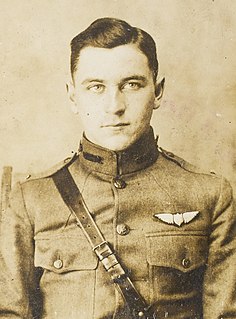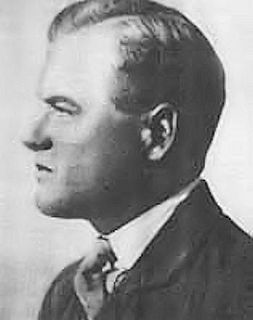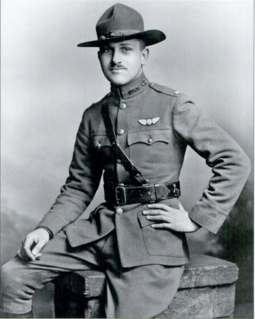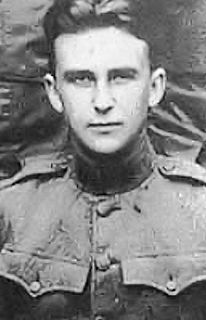
Frank Luke Jr. was an American fighter ace credited with 19 aerial victories, ranking him second among United States Army Air Service pilots after Captain Eddie Rickenbacker during World War I. Luke was the first airman to receive the Medal of Honor and first USAAS ace in day. Luke Air Force Base, Arizona, a United States Air Force pilot training installation since World War II, is named in his honor.

Carl Andrew Spaatz, nicknamed "Tooey", was an American World War II general. As commander of Strategic Air Forces in Europe in 1944, he successfully pressed for the bombing of the enemy's oil production facilities as a priority over other targets. He became Chief of Staff of the newly formed United States Air Force in 1947.

General John Charles Meyer was an American World War II flying ace, and later the commander-in-chief of the Strategic Air Command (SAC) and director of the Joint Strategic Target Planning Staff at Offutt Air Force Base, Nebraska. SAC was the United States' major nuclear deterrent force with bombers, tankers and reconnaissance aircraft, and intercontinental ballistic missiles. The Joint Strategic Target Planning Staff coordinated the nation's nuclear war plans and developed the Single Integrated Operations Plan.

Russell Lowell Maughan was an officer in the United States Army and a pioneer aviator. His career began during World War I, and spanned the period in which military aviation developed from a minor arm of the Army Signal Corps to the huge Army Air Forces on the verge of becoming a separate service.

Lieutenant General Hanford MacNider was a senior officer of the United States Army who fought in both world wars. He also served as a diplomat, the Assistant Secretary of War of the United States from 1925 to 1928 and the National Commander of The American Legion from 1921 to 1922. He was also the United States Ambassador to Canada.

Joseph Frank Wehner, also known as Fritz Wehner, was an American fighter pilot and wingman to Frank Luke.

Arthur Raymond Brooks was an American World War I flying ace of the United States Army Air Service credited with shooting down multiple enemy aircraft. Among his most prominent achievements was when he single-handedly took on a squadron of German-flown Fokker planes officially downing 2 of them in one aerial battle piloting his Smith IV Spad XIII. He was a pioneer in the development of radio navigational aids (NAVAIDs) used by pilots for location and navigation as well as air-to-ground communications. Brooks also participated in early endeavors to commercialize aviation as a passenger-carrying business and was one of the earliest commercial pilots involved with carrying mail for the US Post Office Department.

Frank O'Driscoll Hunter was a World War I flying ace, being credited by the United States Army Air Service with downing nine enemy aircraft. Hunter became an advocate of fighter aircraft strategy and tactics. In World War II he served as commanding general of the VIII Fighter Command and, later, the First Air Force.

First Lieutenant Charles Rudolph d'Olive was a World War I flying ace, credited with five aerial victories. He was the last World War I aviator to be declared an ace, in 1963.

Lieutenant George Willard Furlow was a World War I flying ace credited with five aerial victories.

Lieutenant Jesse Orin Creech was a World War I flying ace credited with seven aerial victories. He shot down the final victory of the war for his squadron.

Captain John Owen Donaldson was a World War I flying ace credited with seven aerial victories.

Lieutenant Lansing Colton Holden, Jr. was a World War I flying ace credited with seven aerial victories.

Captain Gorman DeFreest Larner was a World War I flying ace credited with seven aerial victories.

Lieutenant Clinton Leonard Jones, Jr. was an American World War I flying ace credited with eight aerial victories.

First Lieutenant Lloyd Andrews Hamilton was a World War I flying ace credited with ten aerial victories. During five months of 1918 he became an ace with the Royal Air Force (RAF) and then again with the United States Air Service (USAS). Hamilton Air Force Base is named after him.

Lieutenant Howard Burdick DSC DFC was an American World War I flying ace credited with eight confirmed aerial victories.

Lieutenant Chester Ellis Wright was an American World War I flying ace credited with nine confirmed aerial victories. He was the top scoring ace for his squadron.

Captain Thomas Gantz Cassady was an American fighter pilot who served in two World Wars, and was successful in business during peacetime.
Samuel Kaye Jr. was an officer in the United States Army Air Service during the Great War. He scored four victories and three probables while flying with the 94th Aero Squadron.


















